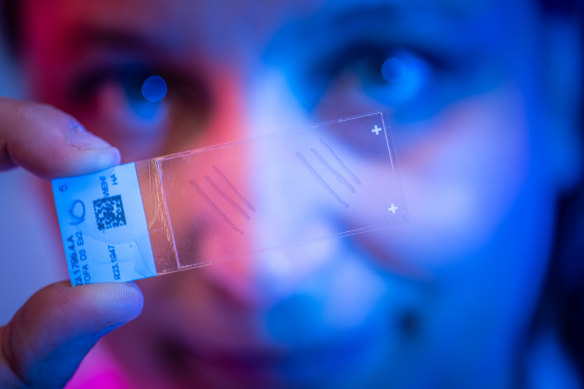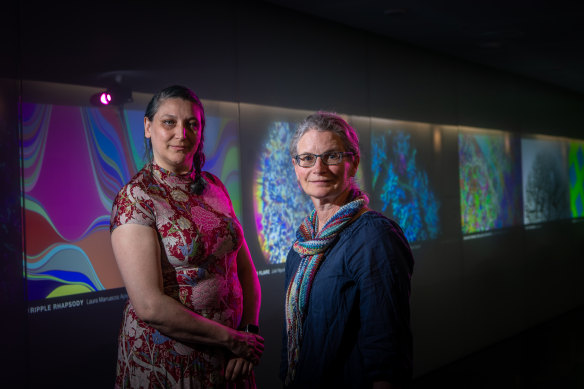By Liam Mannix
A man facing likely death from his own immune system has been saved by an experimental, AI-powered therapy co-developed by a team of Melbourne-based scientists.
Scientific breakthroughs typically take at least a decade to go from lab to clinic if they ever make it at all.
But in a single dramatic stroke, the team cracked the condition’s code, developed a therapy, saved a life and took a big step forward for a new field of medicine: “spatial proteomics”.
They are, understandably, a little giddy with their success.
“I love science,” said Dr Holly Anderton, a researcher at the Walter and Eliza Hall Institute. “I have to admit, I do it for selfish reasons: I’m very curiosity-driven. But there was still this really special moment – actually, there’s someone out there, the work I’ve done … it’s possibly saved their life.
“There’s nothing quite like that.”
It is the first time spatial proteomics has been used to treat a patient. Eric Topol, director of the Scripps Research Translational Institute in California, described the work as “the dawn of spatial medicine” in his newsletter.
The story, told in Nature last month, starts with a disease called toxic epidermal necrolysis, or TEN.
It is exceedingly rare – perhaps two people in a million will get it – and it strikes randomly and horribly.
A drug, often a benign one such as aspirin, will trigger a sudden and overwhelming immune response. Immune cells on the skin and eyes and inside the throat start pouring out toxic proteins; the outer layer of the skin starts to die and slough off.
About one-third of people with TEN die, and many of the survivors are left with life-long injury.
Risk factors are poorly understood, as is the mechanism; there are no effective treatments. “We really don’t understand it at all,” Anderton said.

Dr Holly Anderton, with a slide containing TEN skin samples.Credit: Justin McManus
Enter spatial proteomics
Proteins are the building blocks of life. Each cell in our body contains a network of forges that hammer them out whenever the cell needs to do anything: eat, divide, attack, die.
Study proteins and you study what a cell is trying to do. But the average human cell produces more than 10,000 proteins, and each cell differs.
Big new advances in microscopes, lasers and AI are now opening up this world to science.
Researchers in Germany applied these techniques, spatial proteomics, to a group of seven patients with TEN; one man’s case was so severe that doctors considered death likely.
Using a laser-scalpel, they sliced out individual cells. An AI model then separated immune cells from skin cells.
A mass spectrometer, which measures the mass and charge of the building blocks of proteins, then identified thousands of proteins in the sick cells.
It immediately became clear the sick cells were producing high levels of interferons, a protein used to kill viruses.
That suggested a new treatment no one had previously considered: JAK inhibitors, which cut the effect of interferon.
But you can’t simply give a new therapy to a patient, even one who is likely to die, without some testing. Enter Anderton. She had developed a mouse model of TEN as part of separate research on wound healing.

Dr Holly Anderton, left, and Natasha Silke, senior research assistant.Credit: Justin McManus
The email arrived from Germany out of the blue: could you test this drug? Anderton jumped at the chance.
It took her several months of work in the animal lab to run the experiments. Anderton remembers coming in one day to find the mice’s TEN lesions had stopped growing. It was a “wow” moment.
“I remember looking at these mice and thinking, ‘This can actually stop it’.”
She emailed the German team. They started the JAK therapy almost immediately.
All seven patients who were treated recovered.
The institute has now set up its own spatial proteomics pipeline. “There is really a major leap,” said Dr Maria Tanzer, one of Anderton’s co-authors and a colleague at the Walter and Eliza Hall Institute.
The obvious targets were diseases in which cell differences matter, such as cancer, where different parts of the same tumour could behave in different ways, said Arutha Kulasinghe, founding scientific director of the Queensland Spatial Biology Centre.
Anderton never met the man whose life she may have saved.
“They are on the other side of the world,” she says. “But I still feel this really special connection.”
Start the day with a summary of the day’s most important and interesting stories, analysis and insights. Sign up for our Morning Edition newsletter.